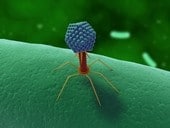We know that bacteriophages are viruses that infect and replicate within bacteria. We know that they are the most abundant organisms on Earth. But we don’t know much about their genetic architecture.
A team of professional scholars and budding scientists–chiefly college freshmen–have joined forces under the aegis of SEA-PHAGES (Science Education Alliance-Phage Hunters Advancing Genomics and Evolutionary Science), which is run jointly by the University of Pittsburgh and the Howard Hughes Medical Institute, to study the little-known genetics of bacteriophages. In a new paper recently published in the journal eLife, the authors show that phages do not form discrete populations as previously suggested but are rampantly exchanging genes with each other to generate a broad spectrum of genetic diversity, albeit with some types being a lot more prevalent than others.
Of the nearly 3,000 authors, 2,664 were students from among 81 colleges and universities that participate in the SEA-PHAGES undergraduate science program, created by Pitt’s Graham Hatfull and colleagues and funded by the Howard Hughes Medical Institute. This paper is believed to have the second-highest number in history of authors on a scientific paper, trailing only that which describes the discovery of the Higgs boson. That paper has more than 6,000 authors.
Forty of the authors on the phages paper are students at Pitt. This level of brainpower was crucial to the paper’s findings says Hatfull, the Eberly Family Professor of Biotechnology in the Department of Biological Sciences within Pitt’s Kenneth P. Dietrich School of Arts and Sciences as well as a Howard Hughes Medical Institute Professor.
The numbers, he says, allowed the massive team to sequence a much larger number of complete genomes than those investigators who claimed phages are grouped into discrete groups. “It’s a matter of resolution,” he says, noting that the SEA-PHAGES team looked at more than 600 individual phages. “Our team was able to look at more pixels. We have gained insights into the complexities of the phage population via this higher resolution view of this group of phages.”
The work illustrates “how little of the global phage population has been genomically sampled,” the paper says, and “with a near endless supply of diverse viruses readily accessible for isolation and analyses, large integrated research and education programs like SEA-PHAGES will continue to play substantial roles in defining the nature of the virosphere.”
In addition to making an important finding about the genetic nature of the bacteriophage population, SEA-PHAGES, Hatfull says, has again proven itself to be a valuable, widely implementable course-based research experience.
To date, SEA-PHAGES students nationwide have found thousands of new bacteriophages (all catalogued in Pitt’s Mycobacteriophage Database) and have been listed as coauthors of more than 10 scientific journal articles. The students get to name their own phages, which not only is fun but also gives students a sense of ownership over their contributions to phage research. The course has proven to deeply engage students in STEM disciplines, and SEA-PHAGES “graduates” are more likely to continue in the sciences, one of the faster-growing fields in today’s global economy.
As a practical scientific matter, the discovery and genetic profiling of new bacteriophages is shedding light on what information their genes encode and what individual genes do, enabling a better understanding of their role in the environment (how they impact carbon turnover rates) and their role in bacterial pathogenesis (how bacteria make us ill).
If our reporting has informed or inspired you, please consider making a donation. Every contribution, no matter the size, empowers us to continue delivering accurate, engaging, and trustworthy science and medical news. Independent journalism requires time, effort, and resources—your support ensures we can keep uncovering the stories that matter most to you.
Join us in making knowledge accessible and impactful. Thank you for standing with us!

